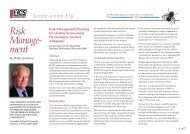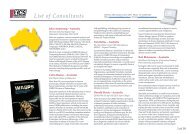Manual for Diagnosis of Screw-worm Fly - xcs consulting
Manual for Diagnosis of Screw-worm Fly - xcs consulting
Manual for Diagnosis of Screw-worm Fly - xcs consulting
Create successful ePaper yourself
Turn your PDF publications into a flip-book with our unique Google optimized e-Paper software.
1. Introduction<br />
Agriculture, Fisheries and Forestry - Australia<br />
Myiasis is the word used to describe an infestation <strong>of</strong> living vertebrate tissue by the larvae <strong>of</strong><br />
flies (Diptera) and is derived from the greek, myia – a fly. It is a widespread condition among<br />
livestock and man (James 1947, Zumpt 1965).<br />
Myiasis has been classified according to the habits <strong>of</strong> the fly species: obligate if the larvae<br />
can only exist on living tissues, facultative, where larvae that normally feed on dead tissue<br />
develop on living tissue if the female opportunistically lays on a living host. Myiasis is also<br />
classified according to the site <strong>of</strong> infestation: traumatic (wound), aural, ocular, nasal and<br />
oral and associated sinuses, anal and vaginal, enteric etc. Some species <strong>of</strong> flies produce<br />
subdermal myiasis when access is via unbroken skin such as the Bot flies (Gasterophilus<br />
and Cuterebra spp.) and the Warble flies (Hypoderma spp.).<br />
There are at least 20 species <strong>of</strong> obligate myiasis-producing Diptera, more than 50 species<br />
which are responsible <strong>for</strong> facultative myiasis and a further 35 species recorded as accidental<br />
agents <strong>of</strong> myiasis (James 1947). Two <strong>of</strong> the most important <strong>of</strong> the obligate myiasis flies are<br />
the Old World screw-<strong>worm</strong> fly (Chrysomya bezziana) and the New World screw-<strong>worm</strong> fly<br />
(Cochliomyia hominivorax).<br />
Identification <strong>of</strong> the fly species implicated in myiasis in our region has confirmed that in most<br />
cases <strong>of</strong> cutaneous myiasis recorded in Africa, Arabia, India and SE Asia, the species<br />
involved is C. bezziana. For example, in Malaysia C. bezziana was involved in 84% and 95%<br />
<strong>of</strong> cattle myiases (Basset and Kadir 1982, Rajamanickam et al.1986). In Papua New Guinea<br />
95% <strong>of</strong> recorded myiases involved C. bezziana (Norris and Murray 1964). In India, 99% <strong>of</strong><br />
myiases in cattle were due to C. bezziana (Narayan and Pillay 1936). A myiasis survey in the<br />
Sultanate <strong>of</strong> Oman showed that C. bezziana was implicated in 93% <strong>of</strong> myiases in goats and<br />
sheep.<br />
The New World screw-<strong>worm</strong> fly, Co. hominivorax, was <strong>for</strong>merly distributed throughout the<br />
southern U.S.A. and is present in Central America, the Caribbean and tropical and subtropical<br />
South America. During summer months, Co. hominivorax used to expand its range<br />
northwards, sometimes infesting up to one third <strong>of</strong> temperate continental U.S.A. (3 million<br />
km 2). Recent eradication programs have eliminated Co. hominivorax from the U.S.A, Mexico<br />
and the Caribbean Islands <strong>of</strong> Curacao, Netherlands Antilles and Puerto Rico (Graham 1985,<br />
Krafsur et al. 1987). Co. hominivorax was accidently introduced to Libya in 1988 (Al-Azazy<br />
1989, Gabaj et al.1989), and was eradicated using sterile flies from Mexico (FAO 1992).<br />
Co. hominivorax and C. bezziana appear to be very similar in many biological and ecological<br />
respects. Co. hominivorax is slightly larger than C. bezziana with smaller eggs and a higher<br />
fecundity (e.g. native Co. hominivorax lay 200-400 eggs per clutch compared with 190-250<br />
eggs in C. bezziana). Female screw-<strong>worm</strong> flies (SWF) <strong>of</strong> both species lay their eggs on the<br />
edge <strong>of</strong> wounds or in and around moist body orifices, the resulting larvae invade the tissues<br />
<strong>of</strong> the host, producing lesions which may lead to loss <strong>of</strong> condition through inappetence,<br />
maiming, infertility if the genitals are infested, or death (Humphrey et al. 1980).<br />
1




